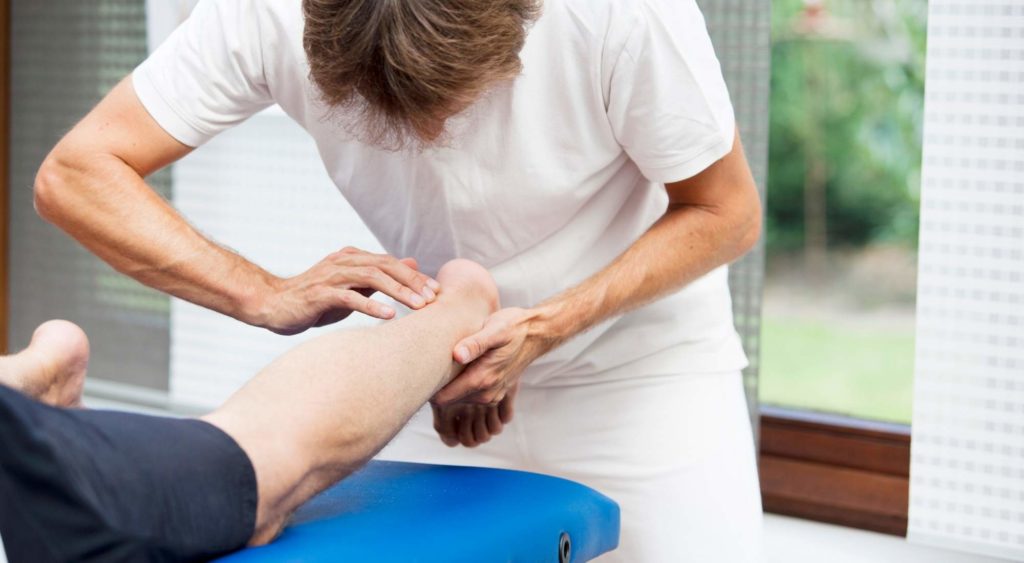Posterior Tibial Tendonitis

Physical Therapy for Posterior Tibial Tendonitis – Information, Exercises, and More
You’ve grown tired of the pain and inability to do everyday activities comfortably due to posterior tibial tendonitis.
You’re looking for more information about what can be done to relieve your symptoms.
Look no further.
In this guide, we’re discussing information, exercises, and more to help you overcome your posterior tibial tendonitis and get back to doing what you love — pain-free.
What is Posterior Tibial Tendonitis?
Your posterior tibial tendon is one of the major supporting structures of your foot. It connects the calf muscle to the bones on the inside of your foot.
Posterior tibial tendonitis (PTT) or posterior tibial tendon dysfunction (PTTD) is a common condition affecting the foot and ankle. PTT occurs when there are changes in the tendon, resulting in the inability to support the arch of your foot.
PTT is the most common cause of flatfoot in adults. It is a progressive disorder that can cause limitations in mobility, pain, and weakness in your ankle and foot.
What Causes Posterior Tibial Tendonitis?
The most common cause of posterior tibial tendonitis is the overuse of the tendon. PTT can also occur as a result of an impact, like a fall or contact during a sport.
People who play sports—dancers and gymnasts are commonly affected—and those who have highly active lifestyles tend to have a higher risk of posterior tibial tendonitis.
Other causes may be due to degenerative changes associated with arthritis, or pre-existing pes planus (flat foot).
Posterior Tibial Tendonitis Risk Factors
People who are more at risk for PTT include:
- Women
- People over the age of 40
- Diabetics
- Young athletes
- People with high blood pressure
- Rheumatoid arthritis
Other risk factors are:
- Obesity
- Steroid usage
- Previous trauma to the ankle
Posterior Tibial Tendonitis Symptoms
Posterior tibial tendonitis typically only occurs in one foot but can occur in both feet. Symptoms include:
- Pain on the inner arch, heel, or ankle
- Swelling
- Flattening of the arch of the foot
- The ankle rolling inward
- Redness
- Foot pain that increases with running, jumping, climbing, or after long periods of standing
- Turning out of the toes and foot
Symptoms usually occur after activities like, running, walking, or climbing stairs. As PTT progresses, the location of your pain may change.
As your foot flattens and heel bone shifts due to PTT, you may begin to feel pain on the outside of your foot and ankle—and can even end up with arthritis in the affected areas.
Posterior Tibial Tendonitis Treatment
Treatment options vary for PTT, but in many cases, non-surgical treatment is enough to overcome the disorder
Non-Surgical Posterior Tibial Tendonitis Treatment
If treated early enough, most cases of PTT may resolve without the need for surgery. These treatments may involve:
- Immobilization
- Anti-inflammatory medicines
- Bracing or other orthotic devices
- Shoe modifications
- Physical therapy
If your symptoms progress or fail to improve with non-surgical treatment, surgery may be necessary.
Surgical Posterior Tibial Tendonitis Treatment
There are a variety of surgeries that can be performed to treat PTT and the right treatment plan for you may depend on several factors, like:
- Severity of deformity
- Presence of underlying arthritis
- Age
- Etc.
Some surgical treatments may involve tendon transfer, hindfoot fusion, or in extreme cases, even a total ankle arthroplasty.
Posterior Tibial Tendonitis Physical Therapy – Will PT Help?
Physical therapy for posterior tibial tendonitis can eliminate foot and ankle pain associated with posterior tibial tendonitis.
Physical therapy focuses on helping you regain:
- Normal range-of-motion of your foot and ankle
- Strength
- Mobility
During your first visit, your physical therapist will assess your condition to determine the main cause of your PTT.
Your treatment plan will involve different components based on your specific needs, but exercise is typically one of the main tools used to treat PTT.
Other treatments during therapy may include:
- Ultrasound
- Kinesiology
- Bracing
- Electrical stimulation
- Massage

Best Posterior Tibial Tendonitis Exercises
Exercise is one of the best ways to combat the pain associated with PTT. Your physical therapist may recommend and walk you through specific exercises based on your unique situation.
Improving mobility and strength are some of the key goals of posterior tibial tendonitis exercises.
Stretching
When combatting PTT, flexibility exercises can help improve mobility in all of the muscle groups in your lower extremity.
How does this improve PTT?
Improved mobility leads to proper foot alignment while walking or running. Some of the best stretches for PTT are:
- Runners stretch
- Ankle stretches
- Hamstring stretches
Strengthening Exercises
Your physical therapist may work with you on strengthening your hips and knees specifically, as those muscles help control the position of your entire leg.
These exercises may include:
- Bridges
- Hip hikes
- Leg raises
- Squats
- Lunges
The goal of PTT exercises is to strengthen your posterior tibial tendon enough to support the arch foot and to be able to control your foot and ankle motion during different activities.
Using a resistance band to do exercises like ankle inversions/eversions and ankle dorsiflexion/plantarflexion, for example, are some of the easiest ways to strengthen the muscles of your ankle.
How In Motion O.C. Can Help With Posterior Tibial Tendonitis
If you are suffering from posterior tibial tendonitis, you are not alone.
As the #1 rated physical therapy center on Yelp! and Google, In Motion O.C. has helped hundreds of people like you recover from PTT.
In Motion O.C. is committed to providing you with the best treatment possible so that you can get back to focusing less on living through the pain and more on the important things in life.
*This information about physical therapy for Posterior Tibial Tendonitis was reviewed by Dr Natalie Thomas, PT, DPT. If you have any questions, please don’t hesitate to contact us here.


